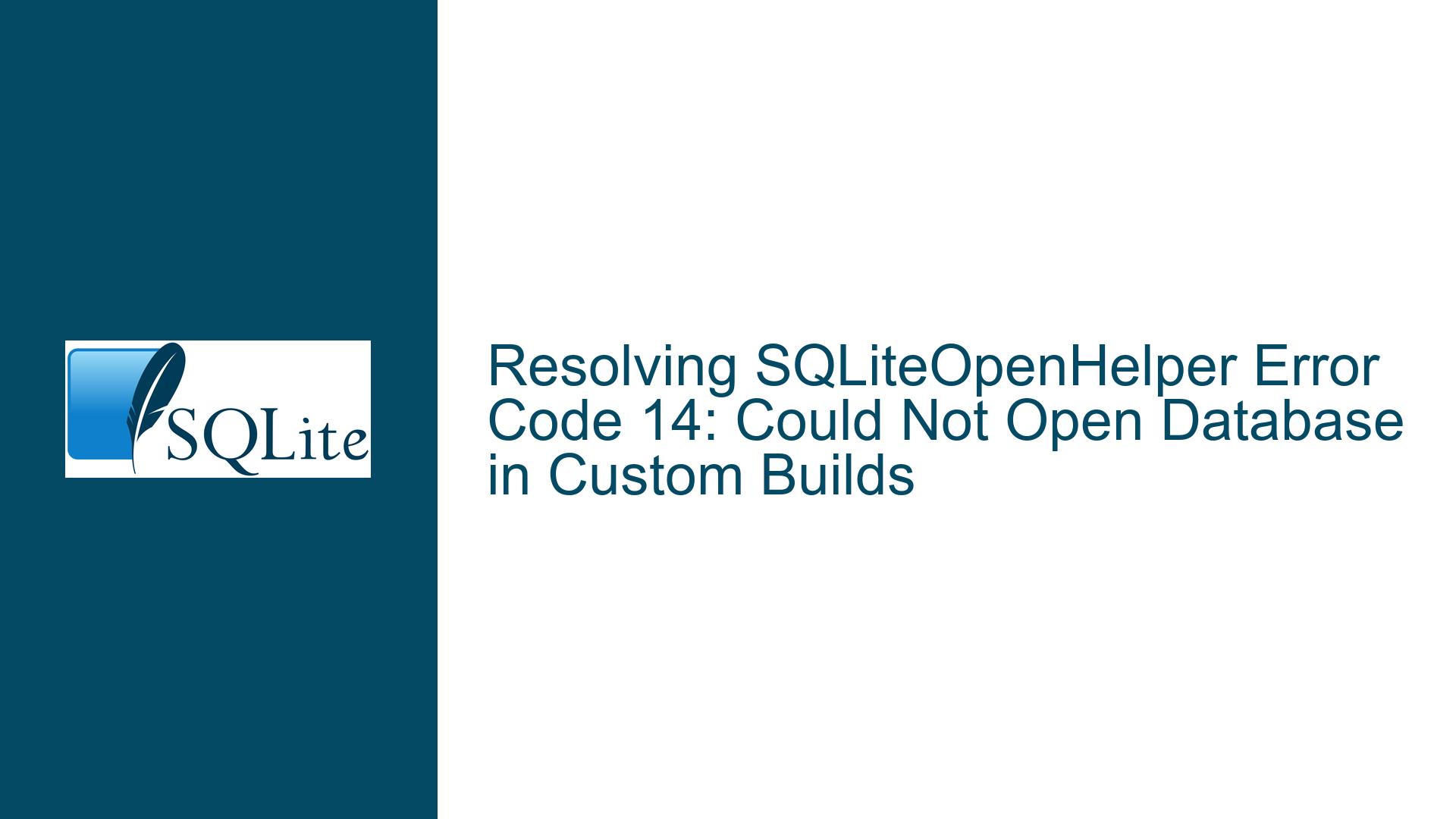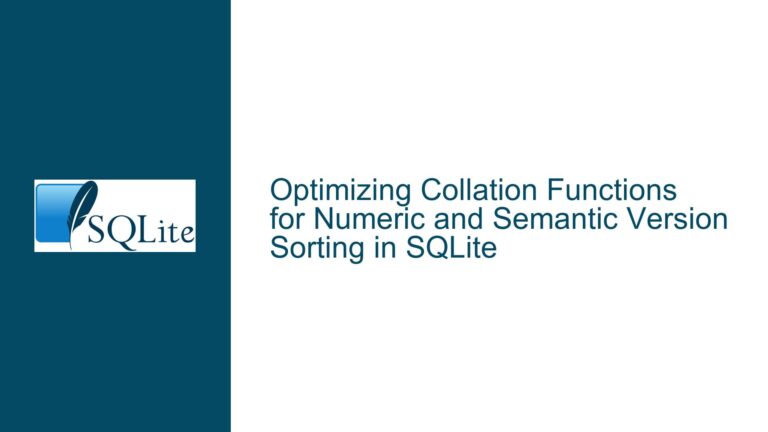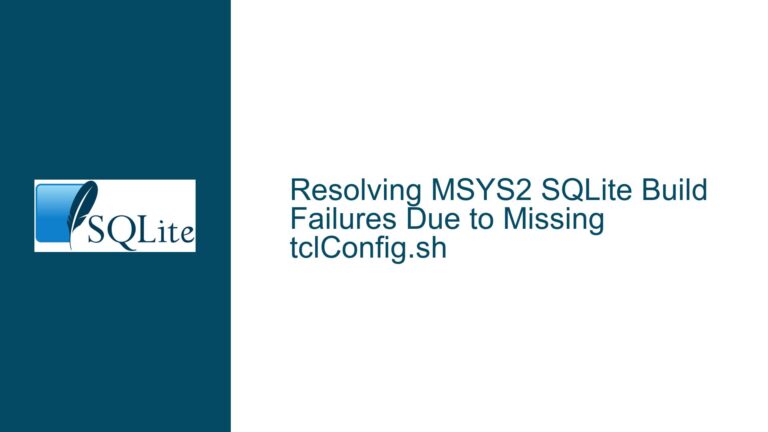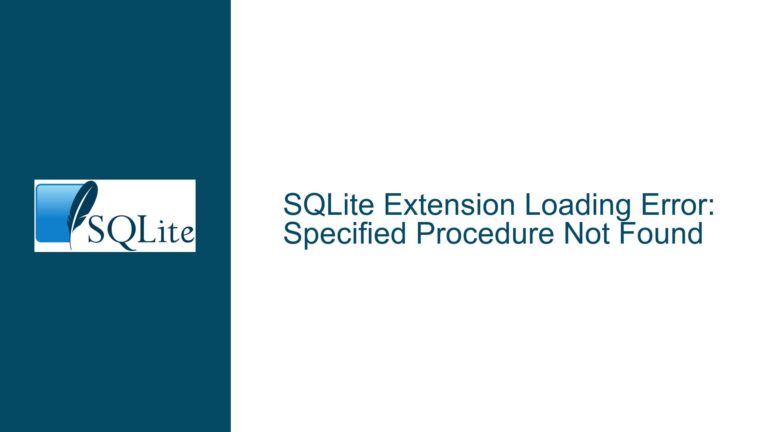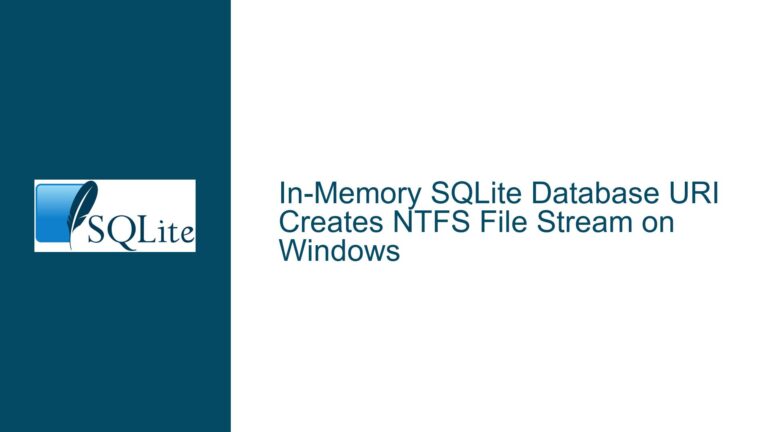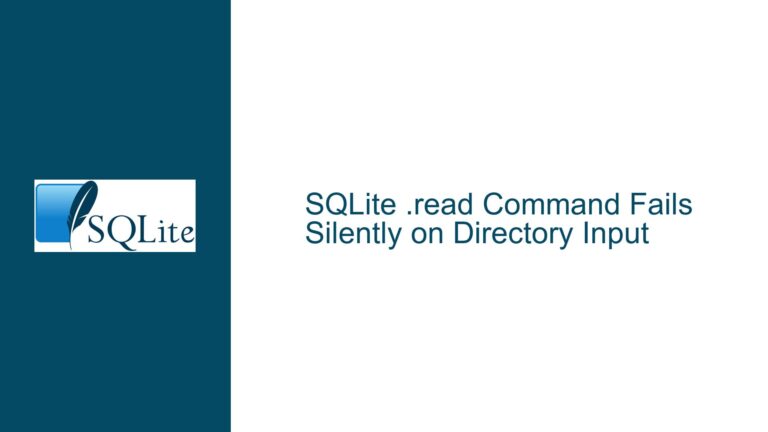Resolving SQLiteOpenHelper Error Code 14: Could Not Open Database in Custom Builds
Issue Overview: SQLiteCantOpenDatabaseException with sqlite-android-3360000.aar
The core problem revolves around an SQLiteCantOpenDatabaseException (error code 14) when using SQLiteOpenHelper from the sqlite-android-3360000.aar library. This error occurs specifically when attempting to open a writable database via getWritableDatabase(), but only when the database name is passed as a simple string (e.g., "MyBuoy.db3") to the SQLiteOpenHelper constructor. The error disappears when the full filesystem path (e.g., /data/user/0/com.gb.mybuoy/databases/MyBuoy.db3) is provided instead.
The user’s goal is to leverage the RTREE compilation option available in this custom SQLite build, which isn’t supported in the default Android SDK’s SQLite implementation. The discrepancy arises from how the SQLiteOpenHelper class in the custom build resolves database paths compared to the standard Android implementation. While the default Android SQLiteOpenHelper automatically resolves relative database names to the app’s private databases directory, the custom build fails to do so under certain conditions, leading to a failure in locating or creating the database file.
Key technical observations from the discussion include:
- Behavioral Differences Between Libraries: The standard Android
SQLiteOpenHelperinternally callsContext.getDatabasePath()to resolve relative database names, but the custom build’sSQLiteOpenHelperdoes not handle this consistently. - Path Resolution Logic: The custom
SQLiteOpenHelperattempts to open the database using the rawmNameparameter first (which may be a relative path), and only falls back toContext.getDatabasePath()in read-only mode after an initial failure. This creates a race condition where the writable mode attempt fails due to incorrect path resolution. - Workaround Validation: Explicitly passing the full path via
super(context, context.getDatabasePath(DATABASE_NAME).getPath(), ...)bypasses the flawed path resolution logic, confirming that the issue is rooted in how the helper class processes the database name.
Root Causes: Path Handling Inconsistencies and Library Bugs
1. Incorrect Handling of Relative Database Names
The custom SQLiteOpenHelper assumes that the name parameter passed to its constructor is either an absolute path or a relative path that can be resolved without relying on Context.getDatabasePath(). This diverges from Android’s default behavior, where SQLiteOpenHelper automatically resolves relative names to the app’s private database directory. When the custom helper attempts to open the database using the unresolved mName, it searches for the file in an unexpected location (e.g., the root filesystem), leading to permission errors or missing directories.
2. Flawed Fallback Mechanism in getDatabaseLocked()
The critical code snippet from the custom SQLiteOpenHelper’s getDatabaseLocked() method reveals a flawed fallback strategy:
try {
db = SQLiteDatabase.openOrCreateDatabase(this.mName, this.mFactory, this.mErrorHandler);
} catch (SQLiteException var15) {
if (writable) {
throw var15;
}
// Fallback to read-only mode using Context.getDatabasePath()
String path = this.mContext.getDatabasePath(this.mName).getPath();
db = SQLiteDatabase.openDatabase(path, this.mFactory, 1, this.mErrorHandler);
}
Here, the initial attempt to open the database uses mName directly. If this fails in writable mode, the exception is rethrown immediately. The fallback to Context.getDatabasePath() is only triggered in read-only mode. This design flaw means that any failure to resolve mName in writable mode will result in an unrecoverable error, even if the correct path could have been derived via Context.getDatabasePath().
3. Missing Directory Creation Logic
Android’s default SQLiteOpenHelper ensures that the parent directory (/data/user/0/<package>/databases/) exists before attempting to create or open the database. If the custom build’s helper skips this step, attempts to create the database file will fail due to missing directories. This is particularly problematic on fresh installs where the databases directory hasn’t been created yet.
4. Build-Specific Bugs in sqlite-android-3360000.aar
The discussion hints at a long-standing bug in the custom SQLite build related to handling file:// URIs and path resolution. This bug likely prevents the helper from normalizing relative paths or constructing absolute paths correctly. The fix provided by Dan Kennedy modifies the SQLiteDatabase.openOrCreateDatabase() method to enforce stricter path validation, which aligns with the workaround of using Context.getDatabasePath().
Solutions: Correct Path Handling, Library Fixes, and Workarounds
1. Explicitly Provide Full Database Paths
The most straightforward fix is to pass the full database path to the SQLiteOpenHelper constructor using Context.getDatabasePath():
public AppDB(Context context) {
super(context, context.getDatabasePath(DATABASE_NAME).getPath(), null, DATABASE_VERSION);
}
This bypasses the custom helper’s flawed path resolution logic entirely. However, this approach hardcodes the dependency on Android’s Context API, which may not be ideal for cross-platform scenarios.
2. Patch the Custom SQLiteOpenHelper Implementation
Modify the getDatabaseLocked() method in the custom SQLiteOpenHelper to resolve mName via Context.getDatabasePath() before attempting to open the database:
private SQLiteDatabase getDatabaseLocked(boolean writable) {
// Resolve mName to absolute path using Context
String resolvedPath = this.mContext.getDatabasePath(this.mName).getPath();
try {
db = SQLiteDatabase.openOrCreateDatabase(resolvedPath, this.mFactory, this.mErrorHandler);
} catch (SQLiteException var15) {
// Handle exceptions...
}
// Rest of the logic...
}
This aligns the custom helper’s behavior with Android’s default implementation. Users can apply this patch by rebuilding the sqlite-android-3360000.aar library with the modified code.
3. Ensure Directories Exist Before Opening
Add logic to verify that the databases directory exists before opening the database:
public AppDB(Context context) {
super(context, DATABASE_NAME, null, DATABASE_VERSION);
File dbDir = context.getDatabasePath(DATABASE_NAME).getParentFile();
if (!dbDir.exists()) {
dbDir.mkdirs();
}
}
This preemptive directory creation mimics Android’s default behavior and addresses cases where the custom helper fails to create directories.
4. Use Updated Builds with Path Resolution Fixes
As suggested in the discussion, switching to a patched version of the custom SQLite build (e.g., the one referenced by Dan Kennedy) resolves the path-handling bug. Users should:
- Download the updated build from the provided URL.
- Replace
sqlite-android-3360000.aarwith the patched version. - Verify that the
SQLiteOpenHelpernow correctly resolves relative database names.
5. Validate File Permissions and SELinux Contexts
In rare cases, the error code 14 could stem from incorrect file permissions or SELinux restrictions. Ensure that:
- The database file and its parent directories have
rwpermissions for the app’s user/group. - SELinux policies aren’t blocking access to the database directory (common in rooted devices or custom ROMs).
6. Test with Read-Only Mode as a Diagnostic Tool
Temporarily opening the database in read-only mode can help isolate the issue:
SQLiteDatabase db = appDB.getReadableDatabase();
If this succeeds, it confirms that the path resolution works in read-only mode (due to the fallback in getDatabaseLocked()) but fails in writable mode. This further implicates the helper’s path-handling logic.
By addressing these root causes and applying the corresponding fixes, developers can resolve the SQLiteCantOpenDatabaseException and successfully use the custom SQLite build with RTREE support. The key takeaway is to always provide absolute paths when working with non-standard SQLite implementations, as their path resolution logic may not align with Android’s defaults.
